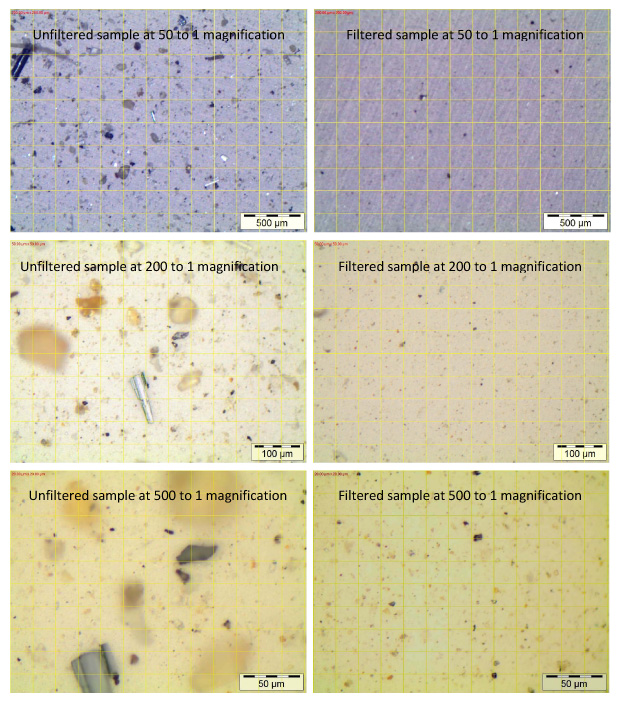For the love of fuel

MALCOLM WALKER of Ultrafine Depth (UD) Filtration offers some very interesting insights on the topic of fuel filtration and fuel quality in South Africa. He feels that everyone in the transport and ancillary industries should be very concerned by the fuel situation as it exists in our country. Walker writes…
There have been a number of articles of late dealing with the quality of diesel fuels available in Africa, but none of the writers seem able to show graphically just how bad the situation is. Any user of diesel-powered equipment will testify to the horrific cost implications of using fuel that is heavily contaminated with dirt particles.
The International Standards Organisation (ISO) has produced a level of cleanliness code in its publication, ISO 4406, which gives a numeric code to the numbers of particles (between a minimum and maximum range) that are found in lubrication fluids and fuels.
This was done in an attempt to classify the cleanliness of the fluids and set minimum standards, which suppliers are encouraged to achieve. The chart allocates single and double-digit numeric codes to huge numbers of dirt particles, in an effort to make these amounts more readable. Because these numbers increase exponentially as the particles become smaller, they use a logarithmic scale.
This means that for every step in the scale, the number of particles doubles, so a code of ten would mean more than 500 and less than 1 000 particles of a certain size. A code of 11 would mean more than 1 000 and less than
2 000 of a specific size, per 100 ml of fluid.
Onboard fuel filters are required to remove this dirt, in order for the engine to operate efficiently for a long time. So does this happen? Onboard filters do remove some of the dirt particles, but, as they use a small amount of relatively inexpensive filter medium, their performance is limited.
In the pictures on the following page, a sample of 20 litres of fuel was deliberately contaminated with 20 g of fine test dust, and left exposed to atmospheric dust for two weeks, after which a sample was taken to microscopically examine the contamination. The test fuel was then passed through a filter that comes as standard equipment on a vehicle, and another sample taken for examination.
These pictures show that the filter was unable to remove the large amount of dirt from the test fuel. Up to 80 percent of engine failures can be traced back to dirty fuel. When the fuel passing through the system is not kept in pristine condition, the working life of the turbo, catalytic converter, engine oil, pistons and rings, valves, and the engine as a whole, is dramatically shortened. The fuel system itself suffers with pump wear and progressive wear and tear of injectors, resulting in increased fuel consumption and eventually injector and/or pump failure.
Four factors contribute to the increase of fuel flow through the injector:
Stiction: This happens when the movement of the injector needle within the barrel becomes “sticky” as dirt particles greater than the dynamic clearances are trapped between the moving parts. Scoring on the needle can be clearly seen with the naked eye and the extent of the damage is huge when viewed under a microscope. Interference with the movement of the needle lengthens injection time and can also prevent the injector from closing properly to shut off the fuel flow into the combustion chamber.
Pitting and wear on the needle and seat: This is caused when very hard particles are trapped between the two surfaces. Surface fatigue and extreme temperatures at the point of contact can cause minute pieces of the surface to be torn off, leaving a channel, through which the fuel can escape into the cylinders of the engine, when the injector should be closed. Both of the first two events contribute to over-fuelling and injector dribbling.
Spray hole enlargement by fluid erosion: This has the effect of reducing the injection pressure within the spray tip. This means that the fuel is not blasted out of the holes with enough force to properly atomise, resulting in a slow burn with high exhaust gas temperatures and unburnt fuel being lost out of the exhaust.
The pilot valve is held open by dirt particles: This drains pressure from the head of the needle. Although the pressures within the injector are very high, the force to hold this valve closed is of necessity quite low and small dirt particles will hold this valve open without damaging the seat. The reduced pressure will not help close the needle, which may also cause the injector to dribble intermittently, adding to the problems described above.
In an effort to combat this dirt attack, protect their products and give acceptable working life, the engine manufacturers install onboard filters to remove the dirt, before it destroys expensive pumps and injectors inside the warranty period. This may seem reasonable, and quite noble, until a user reads the small print of his warranty, and discovers that these items are regarded as wearing parts (in the same way as brake pads and tyres) and are, therefore, not covered.
This tricky practice has only emerged within the last few years, after the manufacturers found they were being killed with warranty claims resulting from the use of dirty fuel. We have seen many vehicle and equipment owners who have been stung by this unsavoury practice of the equipment suppliers hiding behind the use of dirty fuel, whilst not supplying adequate filtration systems on their machines.
Why then do the manufacturers not specify and fit more efficient filters on the vehicles? The answer, although it will never be admitted by the industry, is simple: the sale of spare parts and servicing generate huge profits for their distribution outlets. The manufacturers require these outlets to be profitable and thus sustainable, thereby improving the overall product value, by providing service, in the highly competitive world market.
One could say, therefore, that they have a vested interest in shortening the working life of certain parts. The headlong surge towards a “greener” planet has played right into the hands of these same manufacturers, as they modify and improve engine efficiency and power, without having to ensure that the fuel with which these new technologies are designed to operate, is, in fact, used by the consumer.
The manufacturers of filters also play a role in this circle of deceit. Constrained by vehicle manufacturers to provide small filters that can handle minimum flow specifications and reach a long service life, they are forced (and seem happy to) use inefficient filter media that have relatively large holes, and will thus not block up and cause the vehicle to stall.
Another fact to note is that a relatively low percentage of the dirt that passes through the fuel system comes with the fuel supplied by the fuel companies. Depending on the environmental conditions, up to 80 percent of this dirt could be ingested into the system through the fuel tank breather. Therefore, filtration of the fuel before it goes into the vehicle is not the complete solution to the problem.
A system that incorporates dispensing pump filters and efficient onboard units, which will clean the fuel properly, before it passes through the pump and injector system, would alleviate most of the costly ramifications that come with dirty fuel.
Problems caused by dirty fuel can be kept to a minimum with proper filtration. Fuel filtered to cleanliness levels way beyond those recommended by the engine manufacturers, will greatly improve the productivity and useful life of diesel power plants.

Published by
Focus on Transport
focusmagsa




